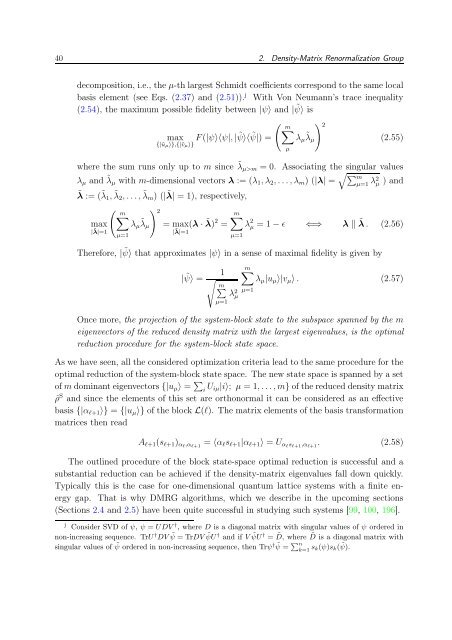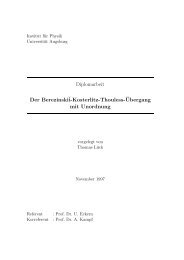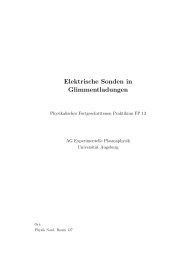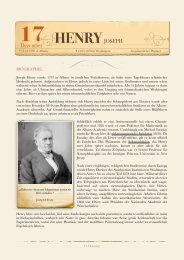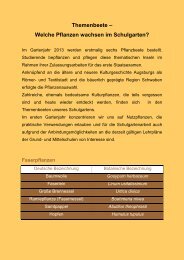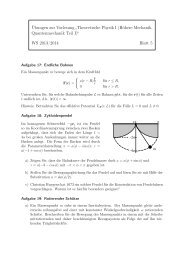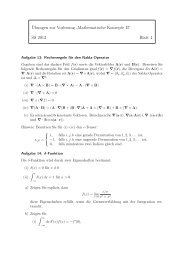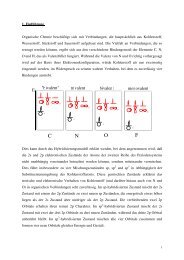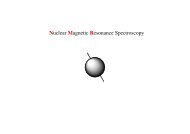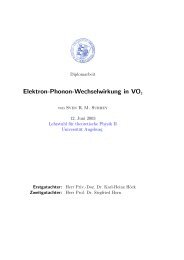PhD Thesis - Universität Augsburg
PhD Thesis - Universität Augsburg
PhD Thesis - Universität Augsburg
Create successful ePaper yourself
Turn your PDF publications into a flip-book with our unique Google optimized e-Paper software.
40 2. Density-Matrix Renormalization Group<br />
decomposition, i.e., the µ-th largest Schmidt coefficients correspond to the same local<br />
basis element (see Eqs. (2.37) and (2.51)). j With Von Neumann’s trace inequality<br />
(2.54), the maximum possible fidelity between |ψ〉 and | ˜ψ〉 is<br />
max F(|ψ〉〈ψ|, | ˜ψ〉〈 ˜ψ|) =<br />
{|ũ µ〉},{|ṽ µ〉}<br />
(<br />
∑ m<br />
) 2<br />
λ µ˜λµ (2.55)<br />
where the sum runs only up to m since ˜λ µ>m = 0. Associating the singular values<br />
λ µ and ˜λ µ with m-dimensional vectors λ := (λ 1 , λ 2 , . . .,λ m ) (|λ| =<br />
√ ∑m<br />
µ=1 λ2 µ ) and<br />
˜λ := (˜λ 1 , ˜λ 2 , . . ., ˜λ m ) (|˜λ| = 1), respectively,<br />
max<br />
|˜λ|=1<br />
( m<br />
∑<br />
µ=1<br />
) 2<br />
λ µ˜λµ = max(λ · ˜λ) 2 =<br />
|˜λ|=1<br />
µ<br />
m∑<br />
λ 2 µ = 1 − ǫ ⇐⇒ λ ‖ ˜λ . (2.56)<br />
Therefore, | ˜ψ〉 that approximates |ψ〉 in a sense of maximal fidelity is given by<br />
µ=1<br />
| ˜ψ〉 =<br />
1<br />
√<br />
m∑<br />
λ 2 µ<br />
µ=1<br />
m∑<br />
λ µ |u µ 〉|v µ 〉 . (2.57)<br />
µ=1<br />
Once more, the projection of the system-block state to the subspace spanned by the m<br />
eigenvectors of the reduced density matrix with the largest eigenvalues, is the optimal<br />
reduction procedure for the system-block state space.<br />
As we have seen, all the considered optimization criteria lead to the same procedure for the<br />
optimal reduction of the system-block state space. The new state space is spanned by a set<br />
of m dominant eigenvectors {|u µ 〉 = ∑ i U iµ|i〉; µ = 1, . . .,m} of the reduced density matrix<br />
ˆρ S and since the elements of this set are orthonormal it can be considered as an effective<br />
basis {|α l+1 〉} = {|u µ 〉} of the block L(l). The matrix elements of the basis transformation<br />
matrices then read<br />
A l+1 (s l+1 ) αl ,α l+1<br />
= 〈α l s l+1 |α l+1 〉 = U αl s l+1 ,α l+1<br />
. (2.58)<br />
The outlined procedure of the block state-space optimal reduction is successful and a<br />
substantial reduction can be achieved if the density-matrix eigenvalues fall down quickly.<br />
Typically this is the case for one-dimensional quantum lattice systems with a finite energy<br />
gap. That is why DMRG algorithms, which we describe in the upcoming sections<br />
(Sections 2.4 and 2.5) have been quite successful in studying such systems [99, 100, 196].<br />
j<br />
Consider SVD of ψ, ψ = UDV † , where D is a diagonal matrix with singular values of ψ ordered in<br />
non-increasing sequence. TrU † DV ˜ψ = TrDV ˜ψU † and if V ˜ψU † = ˜D, where ˜D is a diagonal matrix with<br />
singular values of ˜ψ ordered in non-increasing sequence, then Trψ † ˜ψ = ∑ n<br />
k=1 s k(ψ)s k ( ˜ψ).


